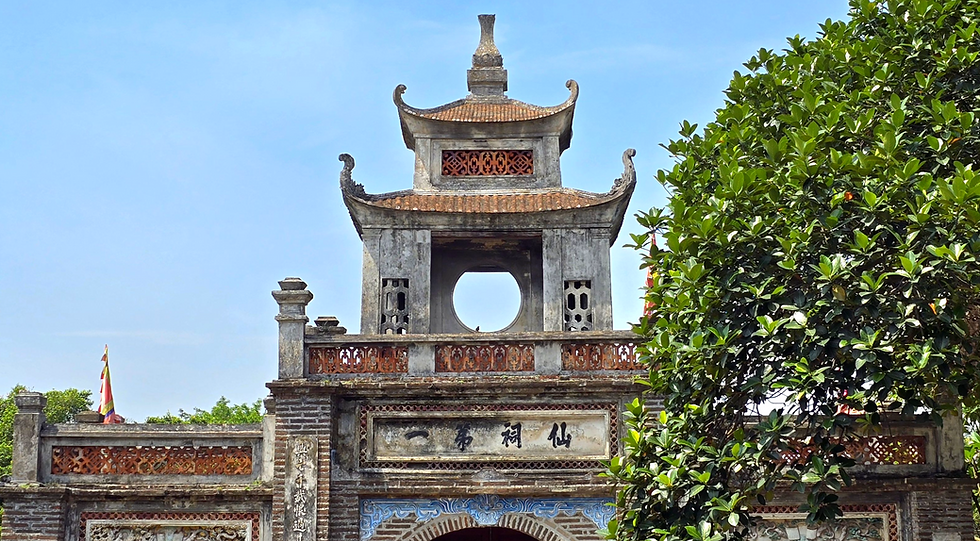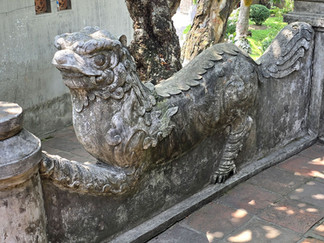Co Loa Ancient Citadel
- Shannon
- Sep 27
- 5 min read
Spirals of Treason - The Fortress That Betrayed Its King
Built in 208 BC, Co Loa Citadel rose as the capital of the ancient Âu Lac kingdom under the legendary King An Duong Vuong. Set upon the northern floodplains of the Red River Delta, the fortress coiled with nine concentric ramparts and moats, earning the name “Loa Thành”, the old spiral. Hailed by archaeologists as Vietnam’s oldest and most formidable stronghold, its vast scale and unique design have long inspired awe, where history and legend intertwine along its spiraled walls.

Sprawling across a vast 500 hectare area, Co Loa Citadel’s walls rise between 6 and 12 metres high, forming three concentric rings of three that together create a complex, multi layered defense system. Each layer was designed to function independently, forcing any invading army to breach multiple fortified barriers while exposing them to counterattacks at every turn. The walls were built strong enough to absorb and withstand the shock of enemy strikes and the innovative design was so advanced for its time that it gave defenders a remarkable strategic advantage, making Co Loa one of the most formidable fortresses in the ancient world.

The largest outer wall guarded the major city and was home to soldiers and the general population. The stronger middle wall acted as a second line of defence, guarding important administrative buildings, crucial defensive weaponry and elite troops. The innermost circle served as the royal residence of the King, his mistresses and high ranking officials. This area was deemed almost impenetrable. The large system of deep moats, fed by nearby rivers, provided an additional barrier of defence against hostile forces and subterranean tunnels linked important fortress sites, allowing essential supplies & infantry to secretly move across a siege.
The story of King An Duong Vuong and this astounding engineering feat is steeped in folklore. According to legend, the walls of the citadel kept collapsing during construction. The ancient ruler evoked the gods and received divine instructions from a sacred golden turtle God named Kim Quy. He was directed to relocate the citadel to firmer ground and the spiral fortress stood solidly, in record time. When Kim Quy was summoned back by the gods, he gave the King his golden claw to use as a trigger for a magical crossbow. This supernatural weapon was capable of firing many shots at a time and enabled the King to kill three hundred soldiers with one press of the trigger. With the help of this weapon and the wisdom of the turtle demigod, King An Duong Vuong succeeded in protecting his kingdom for nearly 30 years.

Sadly, this weapon was also his downfall, creating another legend of love, betrayal and murder. An ambitious Chinese warlord and northern rival named Triệu Đà attempted to invade Co Lao on many occasions, but couldn't succeed. To devise his scheme, he negotiated a peace treaty and sent his son, Trong Thu to the King's court to ask for the hand of his only daughter, the beautiful Princess My Châu. The King approved and Trọng came to live in the kingdom. Through My Châu, Trong learned of the secrets of the King and how the magic crossbow kept the kingdom protected. He secretly stole the magic claw and sought permission to see his father, the rival warlord.

Before he left, he made a promise to his beloved wife that in case of conflict, he would come back for her. In return, My Châu promised she would drop goose feathers on her path so he would be able to find her. After receiving the magical claw from his faithful son, Trieu Đà raised a sudden attack against the King and obliterated them. With Princess My Châu behind his horse, the King fled to the south but when he reached the seashore, there was no help in sight. In desperation, the king called on the golden turtle for guidance. Kim Quy told the king of his daughter’s innocent betrayal and instructed him to behead her. With that, the golden turtle took the King below the waters and they both disappeared.
Guided by her feather trail, Trong Thuy followed the path of his princess bride to the seashore and found the body of his wife lying in a pool of blood. With deep remorse over her death, he returned her headless body to the royal citadel and buried her there. He then drowned himself in the palace well, where the princess would wash her hair.

There is archaeological evidence of prehistoric human habitation in the area up to 20,000 years ago. Various relics of the Bronze Age Dong Son culture were also excavated from the site including weapons and armour, coins, pottery and giant ceremonial bronze drums. The age, size and splendour of Co Loa emphasises the high level of sophistication of these ancient ancestors, debunking the imperialist mindset that Vietnam was civilised by the invading Han army many centuries later.

After the death of the King in 179BC, the fortress city spent the next 2200 turbulent years changing hands between feuding Chinese warlords and dynastic Vietnamese rulers. It eventually lost its status as the country’s political centre and went widely abandoned, transforming the area into a network of fertile rural villages and hamlets. The citadel fortress and its grounds were elevated to a "Special National Relic" in 2012 by the Vietnamese government.

🗺️ Location
Co Loa Citadel Archaeological Site, Thôn Chùa, Co Loa Commune, Đông Anh District, Hà Noi, Vietnam
🚆 How to get there
The citadel is located in Đông Anh District, around 20 km's northeast of the city centre and takes about 45 minutes to reach, depending on traffic. You can take a taxi for about 200000-300000 VND each way. Make sure you negotiate a fair price with the driver and make sure they wait for you and return you to Hanoi. If you prefer a more local experience, you can rent a motorbike and follow Highway AH14 or Võ Chí Công Road across the Nhat Tân Bridge, then continue along Quoc Lo 3 until you see signs for Co Loa. Public buses also run from Long Biên or Mỹ Đình Bus Stations, with Bus 17 being the most common route - though slower, it’s cheap and reliable. Once you arrive, the entrance is easy to spot and the main path leads straight to the ancient spiral ramparts and temple complex.
⭐ Attraction Info
Co Loa Citadel welcomes visitors daily between 8am - 5pm, with tickets priced at 30,000 VND. Despite its historical importance and proximity to Hanoi, the site remains remarkably quiet, offering a peaceful escape from the bustling city. Visitors can wander through the ancient grounds, explore the spiral ramparts and visit the temples and shrines that dot the complex, all while taking in the quiet northern plains. The calm, open spaces make it easy to imagine the kingdom at its height and to reflect on the legends and history embedded in every wall and pathway.
🔗Official Website










































